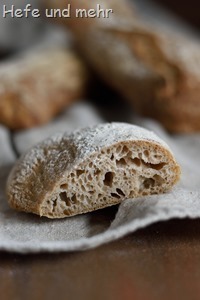 When I was shopping flour in our local mill I discovered a white emmer flour and I couldn’t resist. It was to tempting and I had already the idea of a pure Emmer Ciabatta in my mind.
When I was shopping flour in our local mill I discovered a white emmer flour and I couldn’t resist. It was to tempting and I had already the idea of a pure Emmer Ciabatta in my mind.
The “white flour” of the ancient grains can be varying in their “whiteness” as there is no norm to classify it. My flour turned out to be a darker shade of “white”, so I guess it will equal something between a Type 812 and a Type 1050.
Kneading dough with ancient grain flour needs more attentiveness, as their gluten networks is more fragile and easy to over-knead compared to spelt. So testing gluten development during the kneading is a must here. The window pane test will help to judge this.
The flavour of this bread is great: deep, complex and irresistible nutty but without the slight bitterness of whole grain bread. And I’m already thinking of what to bake next with the other half of the flour bag…
Emmer-Ciabatta
yields 4 Ciabatta
- 500g white Emmerflour
- 350g Water
Dough
- Autolysis
- 4g Psyllium hulls
- 50g Sourdough from the fridge (100% Hydration)
- 25g olive oil
- 10g Salt
- 5g fresh yeast
2. Water addition
- 90g Water
Mix flour and water and let it rest for 60 min at least.
Now add the remaining ingredients of the dough and knead for 5-8min at slow speed, adding the water in small increments while kneading. At the emd, the gluten network should be very well developed and the dough should be sticky.
If possible, place the dough in a square container, as this makes it later more easy to cut the dough into squares. Ferment for 3 hours, folding every 30min, then place the dough in the fridge for at least 16 hours. After that time span dough should be bubbly. If not, increase the fermentation period a bit.
Heat the oven with baking stone to 250°C
Flour the countertop and carefully turn the dough on it. Divide the dough with a dough scrapper into four pieces. Gently stretch the dough pieces to the typical ciabatta shape.
Lay on a couche (floured), cover with a second cloth and proof for 50 min.
Bake on the preheated stone for 35 min with steam.
Deutsch




Seeehr lecker geworden meine Variante mit 75 % Einkornvollkorn Zentrofanmehl und Autolyse wie du empfohlen hattest.
Habe nur 15g Öl (Alba-Öl) im Teig genommen und Gare dann in rechteckiger geölter Plastik Box.
Danke für das tolle Rezept 🙂
@Kerstin: Super, das freut mich 😀
Was ist Zentrofanmehl? 🤔
Liebe Grüsse
Hallo reka herberth,
guck mal hier: http://zentrofan-muehle.de/index.php/die-zentrofan-muhle.html
Dort kaufe ich das Mehl immer wenn ich mal wieder bei meinen Eltern am Bodensee bin.
Bin damit sehr zufrieden, da stets frisch gemahlen und sich das Zenrofanmehl durch diese schonende Mahlart deutlich länger als üblich gemahlenes Vollkornmehl hält.
Zudem ist es seeehr fein (auch feiner als mein mal bei H… Versand gekauftes) und auch aller bestens für sehr fein-fluffig-luftigen reinen Vollkorn Bisquit,… geeignet!
Insbesondere das Einkornvollkornzenrofanmehl mit seinem nussigen Geschmack! 🙂
LG Kerstin
Hallo Stefanie,
da ich noch reichlich Einkornvollkornzentrofanmehl habe und damit gerne fluffige unkomplizierte einfach nur irgendwie abgestochene,… Brötchen/Ciabatta backen möchte, kam mir bei diesem unkomplizierten Rezept mit Autolyse, etwas ASG und Übernachtgare die Idee, dies mit 75% Einkornvollkornzentrofan- und 25% WM 550 zu backen.
Meinst du ich sollte die Autolyse dann nur mit dem Zentrofanmehl ansetzen, oder würdest du trotzdem die kompletten 500g nehmen und dafür mehr Wasser?
LG
@Kerstin: Ich würde die gesamte Mehlmenge für die Autolyse nehmen. Die Wassermenge würde ich bei der zweiten Wasserzugabe regulieren bis ein weicher (aber nicht flüssiger) Teig entstanden ist. Und pass auf, Einkornmehl ist nochmal knetsensitiver als Emmer.
Danke.
Insbesondere das “nochmal knetsensitiver” war mir nicht bekannt!
Aber in diesem Falle passt ja umso mehr ein wenig gekneteter, eher gefalteter Teig dem man einfach nur Zeit gibt und möglichst in Ruhe lässt. 🙂
Und die Flohsamenschalen sind dann ja bestimmt auch sehr vorteilhaft, denke ich.
Liebe Stefanie ,
Ein Versuch für mich .
Ich habe mir Emmermehl aus einer Mühle in Bornholm mitgebracht ( ja ,ich stöbere nicht mehr auf Töpfermärkten,sondern Mühlen ziehen mich magisch an) .Jetzt kann ich es testen und da kein Sauerteig Pflicht ist ,klappt es bestimmt. Bei dir ist Gelinggarantie gewiss .
Vielen Dank ,ich werde berichten
Barbara
@Barbara: Wenn dein Emmermehl allerdings ein Vollkornmehl ist, kann es sein, dass du etwas mehr Wasser brauchst und das es nicht ganz so luftig wird. Aber lecker wird es alle mal 🙂 Und hier gibt es meine ganze Rezeptsammlung mit Emmermehl. Meistens setze ich es allerdings nur in Teilmengen ein, da es zum einen teuer ist, und zum anderen sich so auch die Teigstruktur verbessert!
Liebe Stefanie ,
FINT steht auf der Packung…..Translater sagt ” fein” ,wie ich es mir gedacht habe .
Barbara